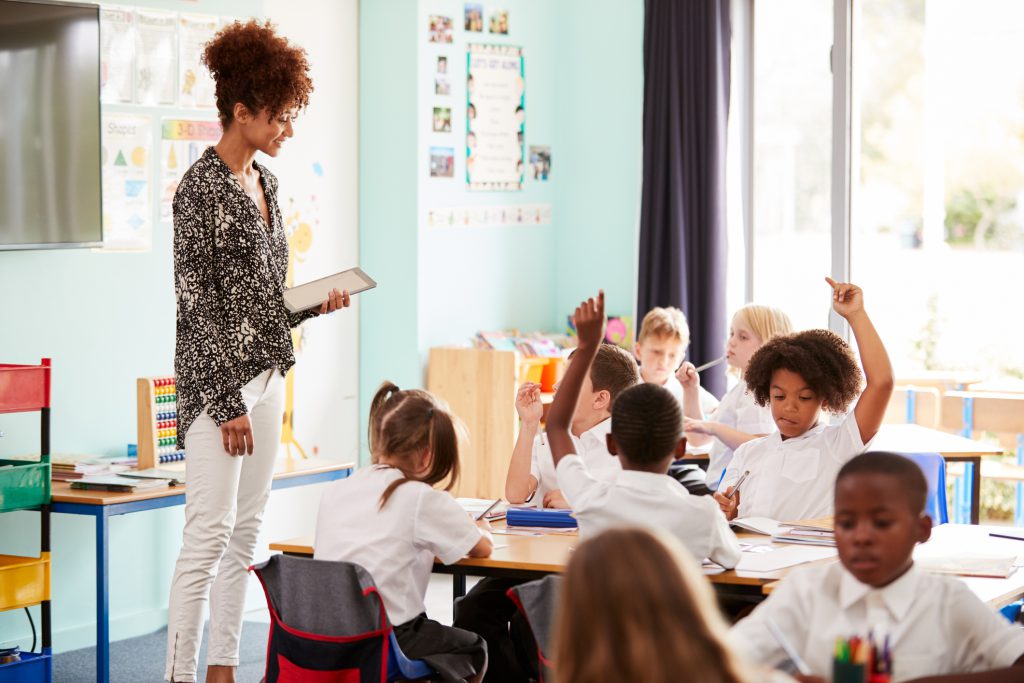
Aric Foster’s energy for teaching his high school students well radiates when he speaks and can be felt even via Zoom.

Aric, who is a graduate of Michigan State University (’01), was placed at Armada High School after graduating. 19 years later, it’s clear that he has earned his status as a veteran teacher, the kind that is the difference-maker for many students during their formidable teenage years. Aric is also a wrestling coach, but off the mats, it’s his will to fight for his students that sets him apart as an educator and as a person. Aric is focused on a core belief when it comes to reaching his students. It’s the belief that strong pedagogical practices can disrupt systemic inequity.
Strong pedagogy can break through systemic inequity. A simple Dictionary.com definition of inequity is defined as “the lack of equity, favoritism, or bias.” Good teaching can reach any student, not just the ones who benefit from the way the system is set up. Note that what Aric is saying is not dismissive of educators; he isn’t clapping back against low test scores with a brash, “Just teach better” attitude. He is articulating that when teachers are equipped with strong pedagogy, they teach all of their students better.
It might seem too good to be true, but Aric is seeing this play out in his classroom. Aric is a fan of TeachingWorks, a University of Michigan-based organization hung up on seeing teachers get the skills they need to effectively teach students. Teachers all over Michigan and beyond who utilize the research-based practices that TeachingWorks champions are experiencing the same positive effects as a result of improving their pedagogy.
Programs alone aren’t going to change the inequitable system; teachers equipped with good pedagogy might, because teachers have the power to be difference-makers. In my conversation with Aric, he emphasized the importance of building relationships. Everything a teacher does has the ability to impact relationships with students. When teachers build rapport with their students and develop a mutual respect, students feel “at home” in their classrooms.
There are a lot of things that have to “go right” for students to raise their hands in a classroom. Did they get enough sleep? Did they eat breakfast? How is their anxiety level today? Do they feel safe at home? Do they feel safe at school? The list of questions goes on. Given the breadth of experiences each student brings to the classroom, practicing in a way that can build trust is important. From being mindful of how to call on students, to the greeting routines teachers have when their students enter the room, every interaction can be a part of building up the teacher-student bond. Obviously, this can be done in a variety of ways, but even using effective pedagogy contributes to an environment of respect, trust, and safety.
Eliciting Student Thinking Honors Student Thinking
Aric brought the link between relationships and pedagogy to life when he discussed the concept of eliciting student thinking. When asking for student feedback, we as teachers often shut down our students without even intending to do so. For example, if a student offers an answer to a question, it’s tempting to shut down the answer immediately if it’s incorrect. Sadly, all too often teachers end up shutting down students when they shut down answers. Instead of saying, “That’s not correct” or “Not exactly”, teachers should honor the student by asking, “How did you get to that answer?” Teachers can elicit student thinking by asking a probing question. If the question is “What is 2 + 2?” and the student answers that it’s 5, the teacher can figure out where the student had a misunderstanding by asking, “How did you get 5 as an answer?” Similarly, if a student says that the answer is 4, which is correct, but doesn’t understand why it’s correct, the teacher can help the student build his/her understanding when eliciting their own thinking. This exchange can give the teacher a lot of information about how learning is going, while simultaneously building rapport between the student and the teacher. Other students who observe these exchanges will see that the teacher is safe, and they, in turn, may feel more comfortable and confident in the classroom.
Aric pointed out something remarkable about the concept of eliciting student thinking: it transcends culture and identity. This pedagogical technique works no matter how a student identifies, what their clothes look like, or how their nuclear family is set up. When we engage student thinking, we honor the student; this allows us to better guide our students to achieve learning objectives.
Content Modeling
The concept of honoring student thinking ties in well to content modeling. When teachers model content, the metaphors they use are extremely important. A classic example Aric pointed to is the “New Bike” or “Bike Riding” experience that many of us have heard as students or used as teachers throughout the years. As a former teacher myself, I know I’ve seen worksheets and standardized tests use the metaphor and/or illustration of a child receiving a new bike. When you consider the diversity present in your classroom, even beyond ethnic diversity, it becomes clear that this metaphor oftentimes doesn’t resonate with all students. Whatever content and/or texts you use, be extra mindful that it accomplishes the learning goal for all students. Teachers, you can disrupt systemic inequity in a small, but consistent way, when you carefully consider the content modeling you use during instructional time.
Assessment
Teachers can gain a better understanding of their students’ proficiency by assessing learning more effectively. Aric offered some simple, helpful tips to honor students through assessment.
- Formative practice is practice. Students use formative practice as a way to work with ideas. When they report these ideas, that is what determines future instruction. None of this should influence a final grade. What this means is that formative work shouldn’t count numerically toward a final grade; the learning shouldn’t be measured in numbers, but in words. So, summative assessments, then, are 100% of a student’s grade.
- Summative assessments should have a clear path toward retakes. Retakes are a touchy subject among educators, but lean in and observe the consistency in the argument. Retakes shouldn’t occur without a “cost” of sorts or at least relearning. Aric’s general suggestion for structuring this is that students can take a summative assessment, and then do a retake if they meet all of the requirements. His example of common requirements includes: “…doing all of the formative work leading up to the summative assessment, doing test corrections, engaging in Khan Academy supplements, and making more flash cards, etc.”
- The final grade is 100% proficiency-based and 0% behavior. Aric isn’t saying that the essential soft skills that develop throughout the instructional process shouldn’t be assessed. In fact, he states, “All measurements of work habits (participation, meeting deadlines, task completion, personal conduct, group collaboration, etc.) are important, need to be taught, and certainly need to be assessed, but should have zero weight in determining a student’s final grade in a course.” This is a time when using words for feedback would be important.
Aric is a stellar teacher, but what he’s doing with these methods is not magic. He’s a normal guy who became passionate about improving his pedagogy when he worked with professors at Oakland University. Aric started attending conferences that discussed systemic inequity and learned ways he could affect change as an educator. Being a “teacher teacher” is what makes his heart beat. The School of Education here at Concordia University Ann Arbor has been enriched by Aric’s work; he guides our Secondary Education majors through a teaching methods course, where he gets to train future educators in best practices. His humility and coachability, not to mention his willingness to work hard, enabled him to be the influential educator that he is today. Aric’s story is a happy one, and the good news is that the skills he developed are all teachable skills.
Aric is focused on a core belief when it comes to reaching his students. It’s the belief that strong pedagogical practices can disrupt systemic inequity.
Teachers, many of you continue to work on these learnable superpowers. My hope for you is that you persist in improving your pedagogy, because good, skilled teachers can disrupt an unfair system.
Bonus: A Few Recommendations for Resources
Brick House: How to Defeat Student Apathy by Building a Brick House Culture by Danny Hill
The Power of ICU by Danny Hill
— Vanessa Lane is the Content Marketing Lead at Concordia University and can be reached at vanessa.lane@cuaa.edu. When she's not at work, she can be found playing with her kids or watching NBA basketball with her husband.
If this story has inspired you, why not explore how you can help further Concordia's mission through giving.